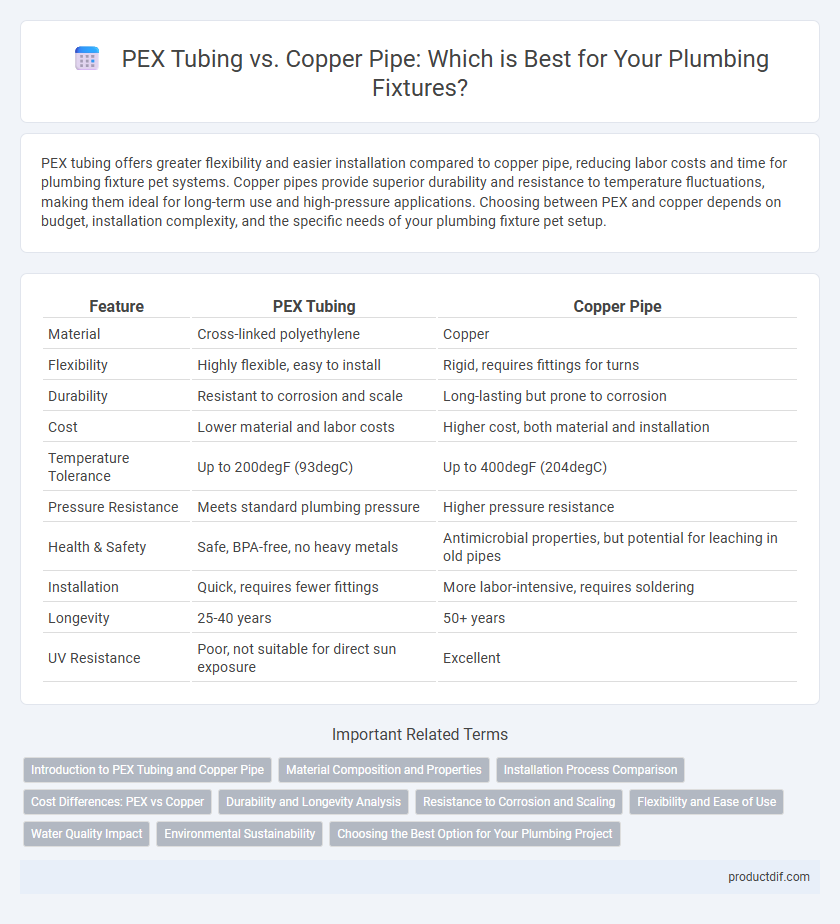PEX tubing offers greater flexibility and easier installation compared to copper pipe, reducing labor costs and time for plumbing fixture pet systems. Copper pipes provide superior durability and resistance to temperature fluctuations, making them ideal for long-term use and high-pressure applications. Choosing between PEX and copper depends on budget, installation complexity, and the specific needs of your plumbing fixture pet setup.
Table of Comparison
| Feature | PEX Tubing | Copper Pipe |
|---|---|---|
| Material | Cross-linked polyethylene | Copper |
| Flexibility | Highly flexible, easy to install | Rigid, requires fittings for turns |
| Durability | Resistant to corrosion and scale | Long-lasting but prone to corrosion |
| Cost | Lower material and labor costs | Higher cost, both material and installation |
| Temperature Tolerance | Up to 200degF (93degC) | Up to 400degF (204degC) |
| Pressure Resistance | Meets standard plumbing pressure | Higher pressure resistance |
| Health & Safety | Safe, BPA-free, no heavy metals | Antimicrobial properties, but potential for leaching in old pipes |
| Installation | Quick, requires fewer fittings | More labor-intensive, requires soldering |
| Longevity | 25-40 years | 50+ years |
| UV Resistance | Poor, not suitable for direct sun exposure | Excellent |
Introduction to PEX Tubing and Copper Pipe
PEX tubing offers flexible, corrosion-resistant plumbing solutions with easy installation and lower material costs compared to traditional copper pipe. Copper pipe, known for its durability and long lifespan, provides excellent resistance to high temperatures and pressure, making it ideal for hot and cold water supply lines. Both materials meet plumbing codes, but PEX's flexibility and resistance to scale build-up make it increasingly popular in modern residential and commercial plumbing systems.
Material Composition and Properties
PEX tubing is composed of cross-linked polyethylene, offering flexibility, resistance to corrosion, and thermal expansion that reduces the risk of cracking in freezing conditions. Copper pipe, made from natural copper, provides superior durability, high thermal conductivity, and is naturally antimicrobial, making it ideal for hot and cold water supply. The choice between PEX and copper hinges on factors like ease of installation, resistance to chemical damage, and long-term performance in diverse plumbing environments.
Installation Process Comparison
PEX tubing offers a more straightforward installation process due to its flexibility and use of push-fit or crimping connectors, reducing labor time compared to copper pipe. Copper pipe installation requires soldering or brazing, demanding higher skill levels and specialized tools, increasing both complexity and costs. PEX tubing's ability to bend around corners minimizes the need for additional fittings, streamlining the overall plumbing layout.
Cost Differences: PEX vs Copper
PEX tubing typically costs between $0.50 and $2.00 per foot, making it significantly more affordable than copper pipe, which ranges from $2.00 to $10.00 per foot depending on diameter and market conditions. Installation expenses for PEX are also lower due to its flexibility and simpler connection methods, reducing labor time compared to rigid copper piping that requires soldering. Overall, PEX offers a cost-effective solution for residential plumbing projects, balancing material savings with easier installation.
Durability and Longevity Analysis
PEX tubing offers exceptional flexibility and resistance to corrosion, making it highly durable in various plumbing environments, including those with acidic or alkaline water. Copper pipe, renowned for its long lifespan, can last over 50 years due to its inherent strength and resistance to microbial growth but is more susceptible to corrosion in highly acidic water conditions. Both materials provide reliable longevity, with PEX favored for ease of installation and resistance to freezing, while copper excels in high-temperature tolerance and structural robustness.
Resistance to Corrosion and Scaling
PEX tubing offers superior resistance to corrosion and scaling compared to copper pipe, as its flexible cross-linked polyethylene material does not rust or develop mineral deposits. Copper pipes, although durable, are prone to corrosion when exposed to acidic water or high mineral content, leading to potential leaks over time. The non-metallic nature of PEX ensures longer-lasting performance in water systems with varying pH levels and hard water conditions.
Flexibility and Ease of Use
PEX tubing offers superior flexibility compared to copper pipe, allowing for easier installation around corners and tight spaces without the need for additional fittings. Its lightweight nature simplifies handling and reduces labor time, making it ideal for complex plumbing layouts. Copper pipe, while durable, requires precise measurements and soldering, which can increase installation complexity and time.
Water Quality Impact
PEX tubing resists corrosion and scale buildup, maintaining consistent water quality over time, while copper pipes can leach small amounts of copper, especially in acidic water conditions, potentially affecting taste and safety. Studies show PEX maintains better water clarity and fewer metallic tastes compared to copper in many municipal water supplies. However, PEX's permeability might allow chemical leaching from surrounding soil or piping additives, which requires consideration based on local water chemistry.
Environmental Sustainability
PEX tubing offers significant environmental benefits over copper pipe due to its lower energy consumption during production and reduced material waste. Copper mining and refining generate substantial carbon emissions and environmental degradation, making PEX tubing a more sustainable choice in plumbing systems. Furthermore, PEX's flexibility reduces the need for fittings and joints, minimizing leak risks and extending the lifespan of plumbing infrastructure.
Choosing the Best Option for Your Plumbing Project
PEX tubing offers superior flexibility, corrosion resistance, and easier installation compared to copper pipe, making it ideal for retrofit and complex plumbing layouts. Copper pipe, known for its durability and natural antimicrobial properties, performs well in high-temperature applications and offers a longer lifespan in UV-protected environments. Evaluating factors such as budget, local building codes, water quality, and project complexity ensures selecting the most suitable material for plumbing efficiency and longevity.
PEX Tubing vs Copper Pipe Infographic

 productdif.com
productdif.com